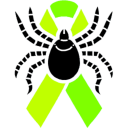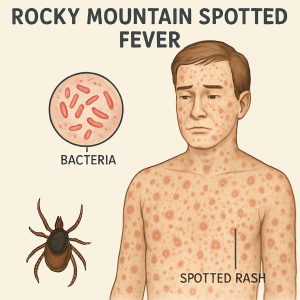Cause & Spread
Despite the name, Rocky Mountain Spotted Fever isn’t limited to the Rocky Mountains. It’s found in many parts of the U.S. and is actually most common in the southeastern states. RMSF is caused by a bacterium named Rickettsia rickettsii. It’s one of the deadliest tick-borne diseases in the U.S. if not treated quickly. RMSF is transmitted through the bite of infected ticks, primarily American dog ticks, Rocky Mountain wood ticks, and brown dog ticks. Different ticks dominate in different regions: The American dog tick (Dermacentor variabilis) is the major carrier in the Eastern half of the U.S. (east of the Rockies) – that covers the Southeast, East Coast, and much of the Midwest. The Rocky Mountain wood tick (Dermacentor andersoni) spreads RMSF in the Rocky Mountain states out West. The brown dog tick (Rhipicephalus sanguineus), which is found throughout the U.S. and worldwide, has been implicated in RMSF cases especially in the Southwest (for example, in Arizona and along the U.S.-Mexico border). In Arizona, for instance, RMSF outbreaks have occurred in communities where brown dog ticks (which usually prefer dogs) bite humans and spread it. So, essentially, if you’re bitten by a dog or wood tick that’s infected, you could get RMSF. The ticks usually need to be attached for a few hours to transmit it, but not as long as Lyme. RMSF bacteria can transmit more quickly.
Regions at Risk
RMSF has been reported in most states, but over 60% of cases come from just five states: North Carolina, Oklahoma, Arkansas, Tennessee, and Missouri. So the south-central and southeastern U.S. is a hotbed. The Rocky Mountain region (Idaho, Montana, etc.) also has cases (hence the name), but actually fewer than the NC/Oklahoma area. The brown dog tick outbreaks have made Arizona another notable area. Basically, if you’re in the Carolinas/Oklahoma area in summer, RMSF should be on your radar.
Symptoms
Rocky Mountain Spotted Fever typically starts fast and furious. It has an incubation of about 3-12 days after the tick bite. It usually begins with a sudden high fever and severe headache. People often feel very ill: high fever, chills, muscle aches, nausea, sometimes abdominal pain that can mimic appendicitis. By around the 2nd to 4th day of illness, a rash often appears – but not always that early (and some people never develop the classic rash). The rash of RMSF is where its name comes from: small pink or red spots that start on the wrists, forearms, and ankles, and spread to the trunk (and sometimes palms and soles). The rash can vary a lot; it often starts as flat spots and later can become petechial (tiny red-purple dots from bleeding under the skin).
Important: In the first few days, less than half of people have a rash, so early on doctors cannot rule out RMSF just because there’s no rash. By the end of the first week, most (90%) of patients will develop some kind of rash, but remember: if untreated, many might be gravely ill by then.
Other symptoms as RMSF progresses can include confusion, or other signs of the infection affecting the brain (encephalitis). If not treated, RMSF can cause serious problems: inflammation of blood vessels all over the body (vasculitis), which can lead to things like bleeding or clotting issues, kidney failure, heart failure, etc. In severe cases, it can cause tissue necrosis (tissue death) leading to amputations of fingers, toes or limbs, or hearing loss, or mental disability. It’s one of those infections that can kill or permanently harm you if not treated quickly, with a fatality rate historically as high as 20-30%. Nowadays, with awareness and antibiotics, fatality in reported cases is around 5-10%, mostly when treatment is delayed. Children under 10 and the elderly are at higher risk of severe outcomes.
Diagnosis
Early diagnosis of RMSF is really tricky. It’s often based on clinical suspicion. If someone has been in tick country (or even if not, because sometimes people don’t realize) and has a high fever and severe headache in the summer, a wise doctor will consider RMSF. They often start treatment right away (because waiting for confirmation is too risky). Blood tests (like antibody tests) won’t turn positive until the second week of illness, which is too late to wait. There is a PCR test that can sometimes detect RMSF DNA early, and skin biopsy of the rash can sometimes confirm it by special staining, but again, these take time. So RMSF is usually a clinical diagnosis initially. Doctors will look at things like low platelet counts, or elevated liver enzymes, which may support the diagnosis.
Treatment
Immediate treatment is critical. If RMSF is suspected, doctors will start doxycycline immediately, often on the very first visit. This can be a life-saving decision. Doxycycline is the treatment of choice for RMSF in adults and children of all ages (just like with ehrlichiosis and anaplasmosis). In fact, RMSF is one of the reasons pediatricians will use doxycycline in young kids despite the general precaution about teeth staining. RMSF untreated can be fatal, so there’s no question about using the best drug. Typically, patients take doxycycline for at least 7-10 days, and importantly, for at least 3 days after the fever has subsided. This usually means treating for about 7-14 days total. Never wait for lab results to treat suspected RMSF. By the time a test comes back positive, a patient could be in serious trouble if not already on antibiotics.
The good news is that if started early, treatment works really well. Many people start feeling better within 2 days of starting doxycycline if it truly is RMSF. If the patient has a severe case, they might need hospitalization, IV fluids, support for any organ failure, etc., but doxy is still the key. There’s no effective alternative antibiotic in RMSF (chloramphenicol can be used in rare cases like pregnancy if doxy can’t be used, but it’s much less effective and has its own risks).
Bottom line: Rocky Mountain Spotted Fever is scary because it can get bad fast, but it’s very curable if you treat it quickly. Time is of the essence. If you have fever + rash in summer or any suggestion of RMSF, getting doxycycline ASAP can literally save your life.

